Updating Your Devices
Downloading and installing periodic software updates is one of the best ways to ensure your devices are performing their best and protected from cyber attacks. Users of University-owned or managed devices are required to install the latest updates. Even when using personal devices, making sure these updates are installed is vital to securing your data. Read below for further details about keeping your devices up to date. For more information, visit IT Security Policies and Guidelines.
Restarting devices to install updates
ITS recommends manually restarting or shutting down your computer and other devices at least once per week. University-managed devices may be restarted automatically to install required security updates. Restarting or shutting down periodically can help you avoid an inconveniently timed automatic system reboot.
Our devices and software are often set to download updates automatically by default. However, these updates may require a complete system restart to take effect. You can manually restart your device by following the instructions below.
Note: Devices must be fully restarted or shut down. Sleeping/hibernating is insufficient for updating.
- At the bottom of the screen, on the left side (Windows 10) or center (Windows 11)
of the Taskbar, click the Windows Start button.

- Select Power.
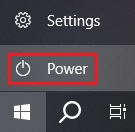
- Select Restart.
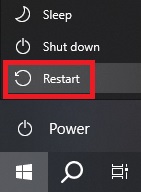
- If your system needs more time to finish installing updates, a message will be displayed until installation is complete. Do not disconnect power from your computer or close your laptop while updates are installing.
For more support or troubleshooting, visit Microsoft Support.
- On the top left of your desktop, click the Apple menu icon.

- Select Restart.
- If your system needs more time to finish installing updates, a message or progress bar will be displayed until installation is complete. Do not disconnect power from your computer or close your laptop while updates are installing.
For more details or troubleshooting, visit Apple's macOS User Guide.
Mobile devices such as phones and tablets have a wide range of operating systems and layouts. However, the most common way to restart or shut down your device is to hold down the power button until a menu appears. Then, select the appropriate option. Your device may take longer than normal to start up if updates are installing.
If you need assistance or experience any problems, contact your department's Local Service Provider or the ITS Service Desk at umtech@memphis.edu or 901-678-8888.
Updating your operating system
Most devices are configured to automatically download and install system updates by default. However, you should periodically check to make sure these updates have installed properly. Optional updates that improve your system performance may also be available. Follow the directions below to check for new updates. Remember to restart your device after installing new updates.
- At the bottom of the screen, on the left side (Windows 10) or center (Windows 11)
of the Taskbar, click the Windows Start button.

- Select Settings.
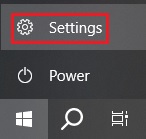
- Select Update & Security.

- The Windows Update screen will appear.
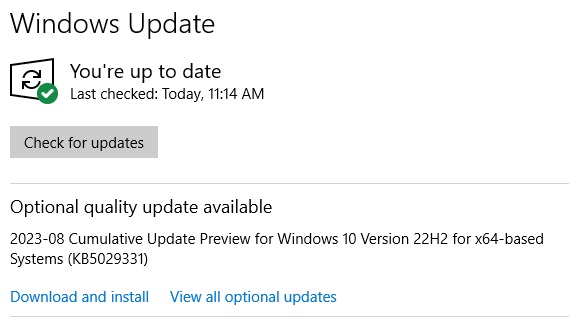
You should see a notification that your device is either up to date or has updates that need to be installed. You will also see any optional updates displayed. Click "Check for updates" to manually search for newer system patches.
Do not disconnect power from your computer or close your laptop while updates are installing. If your device did not restart automatically, restart it now to ensure updates were installed completely.
For more support or troubleshooting, visit Microsoft Support.
- On the top left of your desktop, click the Apple menu icon.

- Select System Settings.
- Select General in the sidebar.
- Click Software Update on the right.
- If you don't see this option, click the Spotlight icon in the top right of your desktop toolbar, then type "Software Update" in the search
bar.

- If you have an older Mac, you might not have Software Update available. Open the App Store (or search "App Store" in Spotlight), then select the Updates tab.
- If you don't see this option, click the Spotlight icon in the top right of your desktop toolbar, then type "Software Update" in the search
bar.
- Your system may display a progress bar or a blank screen. It should return to the desktop or login screen when completed. Do not disconnect power from your computer or close your laptop while updates are installing. If your device did not restart automatically, restart it now to ensure updates were installed completely.
For more details or troubleshooting, visit Apple's macOS User Guide.
If you need further assistance, contact your department's Local Service Provider or the ITS Service Desk at umtech@memphis.edu or 901-678-8888.
Updating your web browser
Your internet browser is the primary way you connect to websites and services, download files, and receive information online. Keeping your browser updated is essential to protecting your device from outside attacks. Most browsers update automatically by default; be sure to close and restart your browser at least once a day to ensure the latest version has been installed. To ensure automatic updates are being applied to your browser, we recommend checking manually at least once per month. To manually check for browser updates, find your browser below and follow the step-by-step instructions.
- Open Chrome.
- At the top right, click the three-dot button to open the More menu.

- Select Help > About Google Chrome.
- Click Update Google Chrome. Important: If you can't find this button, you're using the latest version of Chrome and don't need to update.
- Click Relaunch.
For more details or troubleshooting, visit Google's Chrome Support.
- Open Edge.
- Click the three-dot button to open the Settings and More menu.

- Select Help and feedback > About Microsoft Edge.
- The About page will display your browser's update status:
- If the About page shows "Microsoft Edge is up to date," you don't need to do anything.
- If the About page shows "An update is available," select Download and install. Microsoft Edge will download the update and apply it the next time you restart Edge.
- If the About page shows "To finish updating, restart Microsoft Edge," an update is already downloaded. Select Restart to apply the update.
For more details or troubleshooting, visit Microsoft's Edge Support.
- Open Firefox.
- Click the three-line button on the right side of the Firefox toolbar to open the menu.

- Select Help > About Firefox.
- Firefox will check for updates automatically. If an update is available, it will be downloaded. If no update downloads, you are using the latest version.
- When the download is complete, click Restart to update Firefox.
For more details or troubleshooting, visit Mozilla's Firefox Support.
In current versions of Apple's macOS, the Safari browser is automatically updated with the operating system. To update Safari, check to ensure you have the latest version of macOS.
- On the top left of your desktop, click the Apple menu icon.

- Select System Settings.
- Select General in the sidebar.
- Click Software Update on the right.
- If you don't see this option, click the Spotlight icon in the top right of your desktop toolbar, then type "Software Update" in the search
bar.

- If you have an older Mac, you might not have Software Update available. Open the App Store (or search "App Store" in Spotlight), then select the Updates tab.
- If you don't see this option, click the Spotlight icon in the top right of your desktop toolbar, then type "Software Update" in the search
bar.
- Your system may display a progress bar or a blank screen. It should return to the desktop or login screen when completed. Do not disconnect power from your computer or close your laptop while updates are installing.
For more details or troubleshooting, visit Apple's macOS User Guide.
For additional assistance, visit the support link provided for your browser. If you need further help, contact your department's Local Service Provider or the ITS Service Desk at umtech@memphis.edu or 901-678-8888.
Updating Microsoft Office/365 applications
If you are using the latest version of Microsoft 365, your Office applications (e.g., Outlook, Word, Excel, PowerPoint) will update automatically by default. However, you can check to see whether you have the latest version.
- Open any Office application, such as Word, PowerPoint or Excel.
- Select the File menu on the top toolbar. (Note: When opening current versions of MS 365 apps without opening a specific file, the program starts on the File menu screen.)
- Select Account on the left sidebar.
- On the Account screen, you will see Product Information on the right side. Under Microsoft 365 and Office Updates, you will see a description of your current update settings.
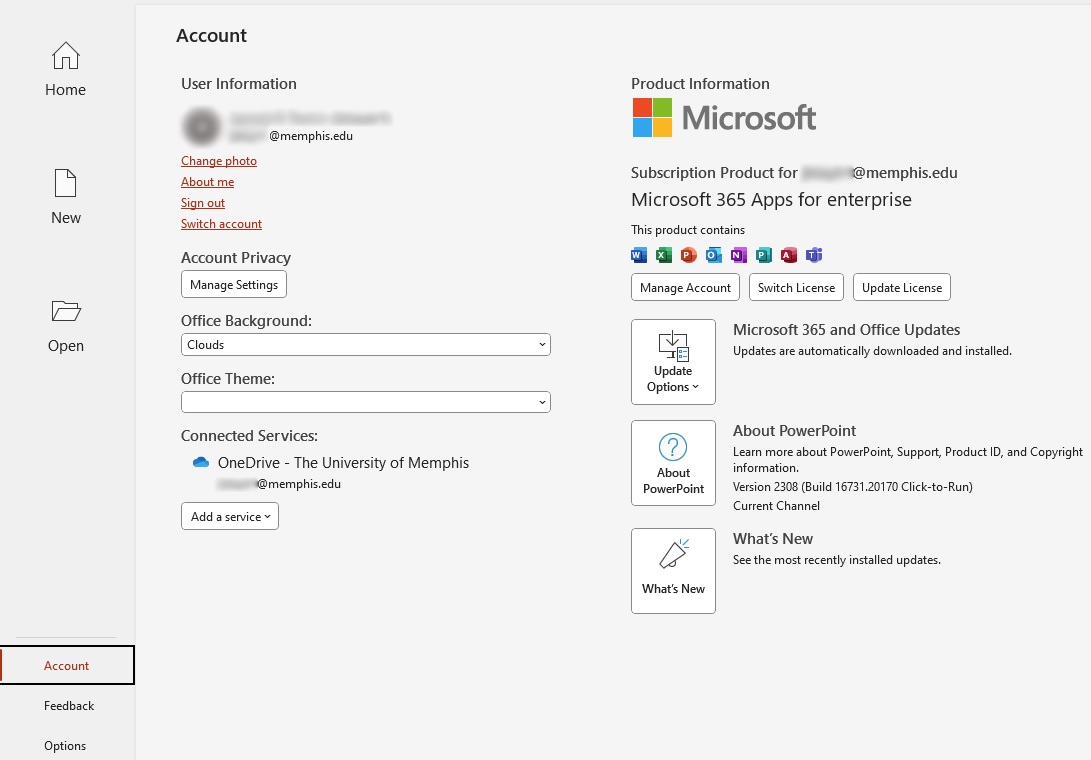
- To manually check for new updates, click the Update Options button, then select Update Now. (Note: You may need to click Enable Updates if you don't see the Update Now option.)
If you have an older version of Microsoft Office, your menus might look different. Generally, you can find update information under the Account or Help menus. For more details, visit Microsoft Support.
- Open the App Store by clicking the icon in the Dock on the bottom of your screen, or click the Apple menu button on the top left of your screen and select App Store.


- Select Updates on the left sidebar.
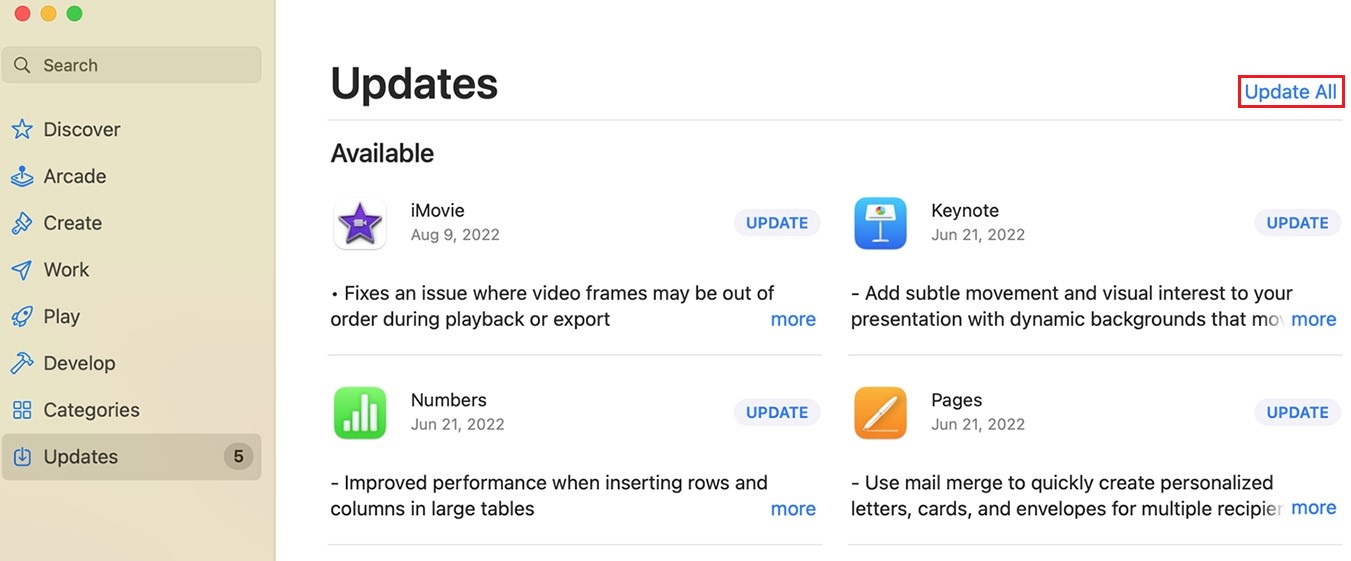
- Click Update All to update every app — including Office — to the latest version, or click the Update button next to each app you want to update.
For more details and instructions to enable automatic updates for Office 365, visit Microsoft Support.
If you need further assistance, contact your department's Local Service Provider or the ITS Service Desk at umtech@memphis.edu or 901-678-8888.

